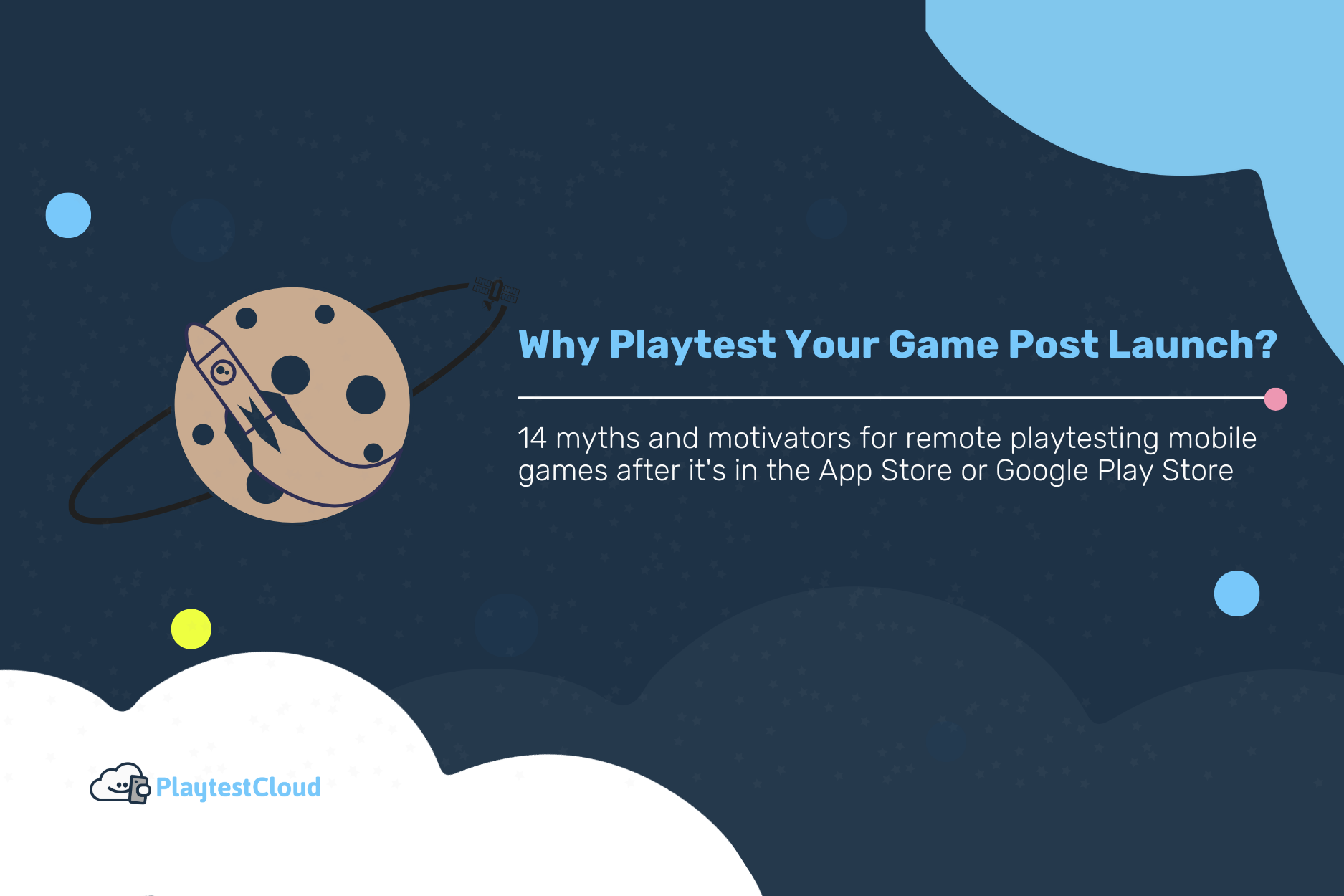From the moment I joined PlaytestCloud, I could see they were literally ‘game’-changers in the world of mobile games development. Now - thanks in part to the years of mobile technology experience I personally bring to the table - I am excited to share some of the more notable myths, motivations, and musings I often hear from our clients about remote playtesting live games.
3 Major Myths of Mobile Playtesting
My work with PlaytestCloud has meant so many great hours connecting with game studio teams, usually over the how-tos of remote playtesting games.
These are brilliant people, intelligent minds on the cutting edge of the industry we serve. Yet there are a few blindspots I’ve noticed when it comes to playtesting. In fact, I often have to dispel the same three myths every time I head into game development team meetings.
The Big 3 Myths about Playtesting Mobile Games Post Launch:
MYTH 1: Post launch playtesting ends when I launch my game
Busted! Playtesting is an arms-reach resource that you’ll need throughout ongoing game-development. Long story short, you’ll remain competitive in your market when you listen (and even watch) testers interact with your game. That’s because these insights also provide inspiration for your team as well, from marketing to design and games user research.
MYTH 2: I should think, “Launch First, Playtest Second”
Busted! Never prioritize your launch over a solid round of remote playtesting. There’s too much at risk in the mind of your players when you don’t design with playtesting in mind; and the odds get worse if you launch without setting your game up for true success on an already saturated market. Playtest first, then launch away!
MYTH 3: I don’t need post launch playtesting... that’s for GaaS only
Busted! Some game studios have been quick to write off post launch playtesting options since they don’t run games-as-a-service (GaaS) frameworks. Take my advice: ‘live-service’ games need real-time playtesting just as much as any other game type out there. Plus it’s a great way to round out your user research arm, no matter your budget.

11 Reasons to Playtest Your Game Post Launch
I’ve noticed something else in my talks with many mobile game studios: a ton of game studios will be indecisive over whether to playtest their game after it's in the App Store or Google Play Store.
I understand completely. We all want long-term users for the games we’re connected with, but when it comes to user research, we’ve been told that community feedback and telemetry are fine to replace playtesting post-launch.
Not to mention, there are budgetary constraints to consider—which can make playtesting financially out of the question for independent or small start-up game studios.
That’s why I strongly believe seeing the way players interact with your game will lead to less spending on QA, a positive gaming environment, and less bugs overall for your development team to handle.
Here are just 11 additional motivators I like to consider when I talk to developers, researchers, and studio managers about playtesting their mobile game(s) in real-time:
Inspire new content and gaming assets
Once you’ve moved on from the base, game-ready tactics needed to launch your game, it’s time to focus on creating new assets—from character design to asset production and development. Post launch playtesting can provide critical inspiration to your team’s games innovation strategy!
Alter your game’s meta environment
As you scale your game to include more players in new audiences, you will inevitably make adjustments to your game’s meta to add new currencies, currency rates, in-game events, and other meta-universe tactics to provide insight to your game. Post launch playtesting helps you see where adjustments are needed in real-time, and keeps you out of survival mode during games redevelopment.
Add new game mechanics or UI/QoL tweaks without fuss
Post launch playtesting helps you streamline new game additions or code changes with less bugs. It helps support the development of a gaming roadmap that every member on your team may use to respond to emerging issues, and proceed with usability testing. Even a single, on-demand, active-player playtest can impact the launch or discovery of new game mechanics, UI tweaks, or improve your gaming environment’s QoL.s.
Easily transition new players into your game
Likely, you’ve added new content and mechanics to the old onboarding system, and with scale these are no longer fit for your users’ needs. Post launch playtesting encourages a simpler transition for new and returning players to your game.
Simplify games-as-service (GaaS) updates
I’ve seen games evolve from simple gaming environments to full-scale GaaS mobile games. I’ve also seen start-off GaaS options reach a block-point where they don’t know how to proceed with updates. Post launch playtesting remotely keeps the gaming ‘cash cow’ fresh, and is an alternative strategy that welcomes new players to your game.
Scale your game’s monetization strategy without barriers to access
Usability and metagame testing will further intersect with monetization as soon as your game goes live. Right away you’ll have to test whether app downloads and store purchases work as intended. Can users navigate easily? Do they understand how to purchase, and the value they are getting? Are you offering options at a good perceived value? Post launch playtesting stimulates innovation toward bringing in more dollars with your game. It helps simplify your monetization strategies for pay-to-play users, while keeping flexible options for free-to-play (FTP) or almost-FTP players to purchase in-game assets. These are all aspects of monetization and user retention that can be addressed in a single, ten-minute, remote playtest completed with users in real-time.
Reduce player churn instantly
As soon as you notice your players are dropping off, it’s easy to get discouraged about all the work you’ve put in. Don’t pull out your hair on this, and don’t spend more on player acquisition than you need to! Post launch playtesting is a direct-response method that lets you see when and where players are dropping off so you can pivot right away.
Lessen the burden of early-day design or development roadblocks
Now that your game is up on the playstore, you’re likely noticing a ton of things ‘you could have done better’. You might not have done enough playtesting early on, are seeing a huge monetization gap, or see the same bug cropping up over and over. Don’t panic. As your game continues to collect long-time players, this new committed community is bound to expose issues. That’s a good thing! While your Google Play and App Store reviews will help, remote post launch playtesting lets you watch players interact to pinpoint where you need to make improvements. That way, you’re less likely to look at your whole game as flawed—usually it’s a much simpler problem than you think!
Respond to unexpected changes in your game’s player demographics
As more and more people take to your game, you might find a group of players popping up that you didn’t anticipate. Post launch playtesting remotely helps you hone in on those audience segments to scope out new content/asset opportunities. It’s also possible that you want to target a certain demographic, but aren’t getting those players. Post launch playtesting remotely helps with that too: you can stay in your developer environment, keep the game live, and use the results as a watchable analytic to almost-instantly gain more desirable players.
Test new gaming tech and infrastructure at any stage
It’s possible that you launched your game years ago, and as successful as it is, it just doesn’t look the same on updated hardware. Post launch playtesting does wonders for any game studio looking to test new layers of tech, or who want to iterate an entirely new infrastructure and tackle UI-related player drop-off.
Reinvigorate your love of mobile games development
Not every game makes the cut—and that’s okay! Once your mourning period is over, it’s time to hit the drawing board with a new strategy. Post launch playtesting remotely lets you develop and iterate at your own pace, wherever you are comfortable. Here’s the real kicker: playtesting your game with active players can also prevent the symptoms of postpartum game depression for those who have launched before, and are afraid of taking another risk. It also reduces the habit of comparing your live game with others so you’re not always keeping up with the joneses, and ultimately helps you build confidence in your own capacity to challenge players and build great games.

How can I start post launch playtesting for my mobile game?
When you’ve decided that playtesting is for you, how do you get started?
If you’re more of an independent games user researcher, I suggest referring to the four steps I listed below on how to remotely playtest your mobile game with active players of your game.
Otherwise, seek out a playtesting service that you trust—I for one love when clients reach out to us with questions about the right option for them.
4 steps to start remotely playtesting any mobile game
1- Research different playtesting types. This initial step will give you a ton of insight on how to approach playtests forever. It will also support the development of strong games user research goals. To get you started, here is a short-list of the five main playtest types we offer at PlaytestCloud:
- Longitudinal and/or multisession playtest - emphasis on user retention, metagame, and appreciation
- Usability single session - focus on day-one retention, new onboarding, and new features additions
- Surveys - gain player insight investigation to support innovation decision-making
- Concept testing - determine sense checks and test player responses with different player groups
- Competitor analysis - make positive comparisons against current industry leaders in your game’s niche
2- Choose the right type of playtest to fit your goals. This is an involved step in the process. I always suggest considering the difference between usability and rapid iteration testing before making a final choice. If you’re stuck here, again I would say to reach out to a playtesting team for help.
3- Choose the right set of players to accomplish your games user research intent. The important question to ask here is, “who are my players?”. A few target areas you might consider are:
- Players who are in the target demographic but don’t play your game currently. Best at stages where you’re reviewing onboarding, first-week retention, and fresh-eyed concept testing.
- Players who currently play your game. This highlights player appreciation, feature usability, as well as concept testing for new, unplayed assets.
- Players who played and then dropped off from regular play. This approach considers churn rates, and all related questions and issues.
- Players who are entirely outside your target demographic. This refocuses your attention on broadening the appeal of your mobile game to a wider audience.
4- Reach out to a playtesting service in the mobile gaming space. Now that you have more of an idea of what you’re getting into, and are hopefully motivated to get cracking with a playtest for your game, it’s time to send a message to a playtesting service that is ready to help! When you’re looking, make sure to choose a tester that has access to a ton of different player demographics—for example we at PlaytestCloud have a community of playtesters over a million strong and growing!
PS: if you still want to chat with someone about playtesting your mobile game, and you want to do it fast, without fuss, and without long-term obligations, I’m right here for you!
Reach out anytime, I literally can’t wait to hear about your game!


